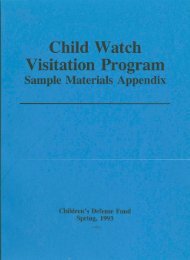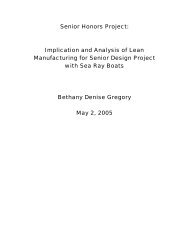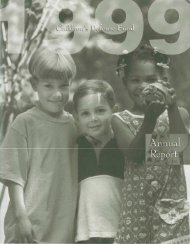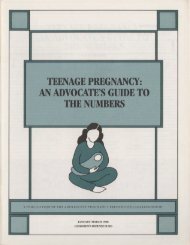child care - Digital Library Collections
child care - Digital Library Collections
child care - Digital Library Collections
You also want an ePaper? Increase the reach of your titles
YUMPU automatically turns print PDFs into web optimized ePapers that Google loves.
CHILD<br />
HEALTH<br />
to 50 percentage points above the old state<br />
eligibility level. Also, because states have leeway<br />
to defme what is counted as income to<br />
determine eligibility, they may be able to design<br />
programs to cover even more uninsured<br />
<strong>child</strong>ren.<br />
• A guarantee of certain benefits. If a state decides<br />
simply to expand Medicaid to include<br />
more <strong>child</strong>ren, Medicaid's EPSDT program<br />
covers all medically necessary <strong>care</strong>. States that<br />
instead decide to create a separate state program<br />
must provide benefits at least equivalent<br />
to those in specified commercial insurance<br />
plans. The state may choose a different combination<br />
of services so long as the total value of<br />
all services is the same as or better than under<br />
one ofthese benchmark commercial plans. Advocates<br />
must work to ensure that the benefits<br />
included in separate state programs take into<br />
account the special health needs of <strong>child</strong>ren<br />
and are not simply modeled on commercial<br />
plans designed to meet the needs of workingage<br />
adults. (See figure 2.3 illustrating differences<br />
in the health problems of <strong>child</strong>ren and<br />
adults.)<br />
• Limits on costs for families. As a general rule,<br />
Medicaid bars states from imposing costsharing<br />
on low-income parents through copayments,<br />
premiums, or other fees for <strong>child</strong>ren's<br />
coverage and <strong>care</strong>. However, CffiP makes limited<br />
cost-sharing permissible in separate state<br />
programs. In such programs, families with income<br />
at or below 150 percent of the poverty<br />
level can be charged no more than the same<br />
small amounts for premiums, deductibles, copayments,<br />
and coinsurance that are permitted<br />
for adults under Medicaid. Families with income<br />
over 150 percent of poverty can be<br />
charged more, but total payments may not exceed<br />
5 percent offamily income. Regardless of<br />
the family's income level, well-baby <strong>care</strong>, well<strong>child</strong><br />
<strong>care</strong>, and immunizations are exempt<br />
from fees.<br />
• Preservation of Medicaid coverage. To receive<br />
grants under the new program, a state must<br />
maintain the Medicaid eligibility standards in<br />
effect for <strong>child</strong>ren in June 1997. A state that<br />
creates a new <strong>child</strong> health program must<br />
screen applicants for possible Medicaid coverage<br />
and enroll all eligible <strong>child</strong>ren in Medicaid.<br />
Figure 2.3<br />
Common Health Problems of Children and Working-Age Adults<br />
Children and workingage<br />
adults have very<br />
different health <strong>care</strong><br />
needs. Children are<br />
300<br />
"a. o<br />
8- 200<br />
Shorl·term medical problems<br />
• Children (under age 18)<br />
• Adults (ages 18-64)<br />
Chronic medical problems<br />
120 .--------------,<br />
• Children<br />
(under age 18)<br />
• Adults<br />
" (age. 18-64)<br />
a. o<br />
8-<br />
107.8<br />
more susceptible to<br />
° o<br />
°o o.<br />
respiratory and ear<br />
infections, for example,<br />
but less prone to certain<br />
chronic conditions, such<br />
~<br />
" a.<br />
'" r::<br />
.,g<br />
'0 100 -<br />
r::<br />
o<br />
U<br />
~<br />
" a.<br />
'" r::<br />
o<br />
;-g 40-<br />
r::<br />
o<br />
U<br />
as arthritis and high<br />
blood pressure, that may<br />
require costly <strong>care</strong>.<br />
All acute<br />
conditions<br />
Respiratory<br />
(onditions<br />
Acute ear<br />
infertions<br />
Asthma<br />
a. So few cases are reported among <strong>child</strong>ren that the estimated rotes for <strong>child</strong>ren are not reliable.<br />
Source: U.S. Deportment of Health and Human Services, National Center for Health Statistics,<br />
1995 National Health Interview Survey. Calculations by Children's Defense Fund.<br />
CHI L D R EN'S D E FEN S E FUN D 29














